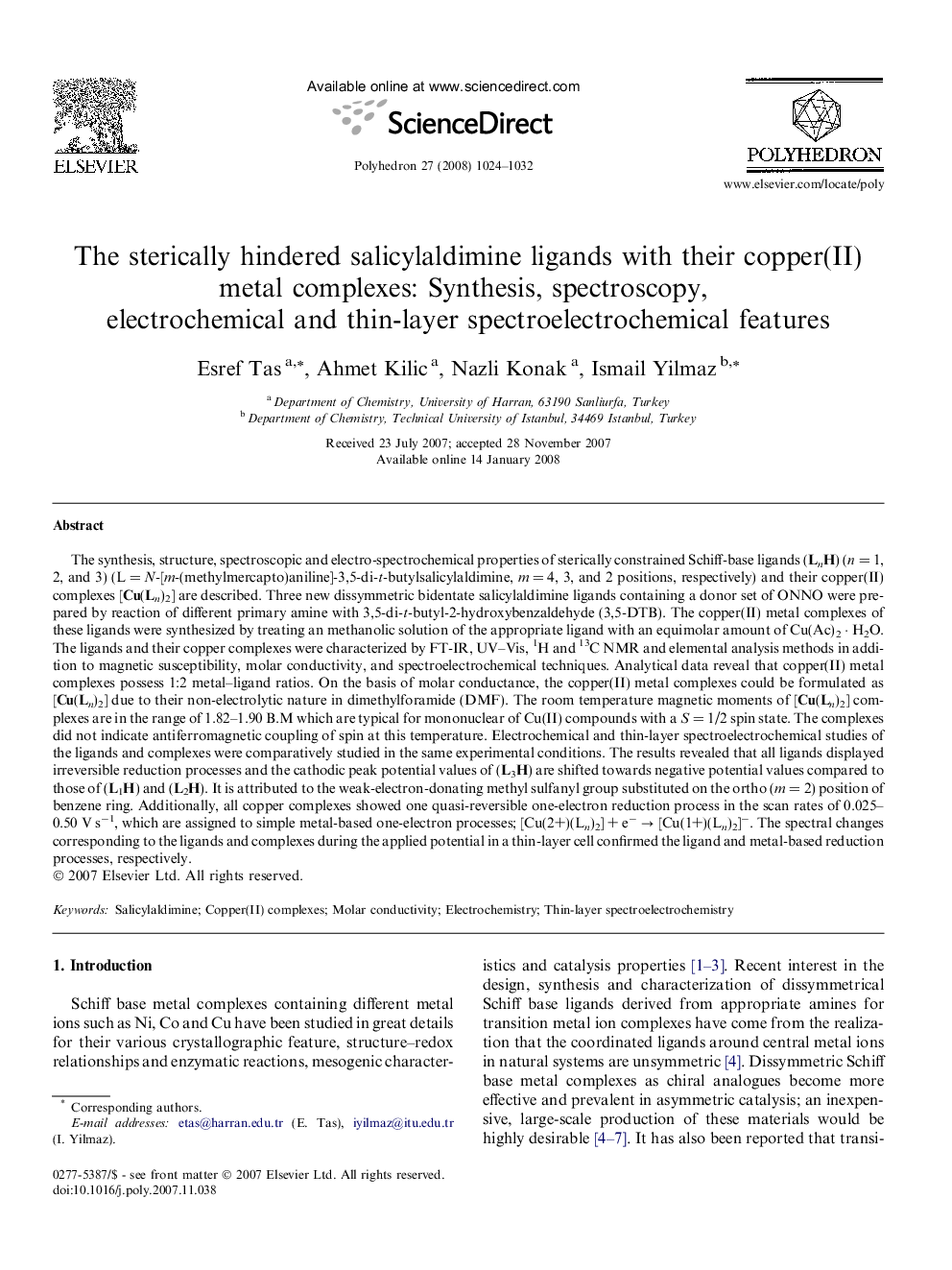| Article ID | Journal | Published Year | Pages | File Type |
|---|---|---|---|---|
| 1340716 | Polyhedron | 2008 | 9 Pages |
The synthesis, structure, spectroscopic and electro-spectrochemical properties of sterically constrained Schiff-base ligands (LnH) (n = 1, 2, and 3) (L = N-[m-(methylmercapto)aniline]-3,5-di-t-butylsalicylaldimine, m = 4, 3, and 2 positions, respectively) and their copper(II) complexes [Cu(Ln)2] are described. Three new dissymmetric bidentate salicylaldimine ligands containing a donor set of ONNO were prepared by reaction of different primary amine with 3,5-di-t-butyl-2-hydroxybenzaldehyde (3,5-DTB). The copper(II) metal complexes of these ligands were synthesized by treating an methanolic solution of the appropriate ligand with an equimolar amount of Cu(Ac)2 · H2O. The ligands and their copper complexes were characterized by FT-IR, UV–Vis, 1H and 13C NMR and elemental analysis methods in addition to magnetic susceptibility, molar conductivity, and spectroelectrochemical techniques. Analytical data reveal that copper(II) metal complexes possess 1:2 metal–ligand ratios. On the basis of molar conductance, the copper(II) metal complexes could be formulated as [Cu(Ln)2] due to their non-electrolytic nature in dimethylforamide (DMF). The room temperature magnetic moments of [Cu(Ln)2] complexes are in the range of 1.82–1.90 B.M which are typical for mononuclear of Cu(II) compounds with a S = 1/2 spin state. The complexes did not indicate antiferromagnetic coupling of spin at this temperature. Electrochemical and thin-layer spectroelectrochemical studies of the ligands and complexes were comparatively studied in the same experimental conditions. The results revealed that all ligands displayed irreversible reduction processes and the cathodic peak potential values of (L3H) are shifted towards negative potential values compared to those of (L1H) and (L2H). It is attributed to the weak-electron-donating methyl sulfanyl group substituted on the ortho (m = 2) position of benzene ring. Additionally, all copper complexes showed one quasi-reversible one-electron reduction process in the scan rates of 0.025–0.50 V s−1, which are assigned to simple metal-based one-electron processes; [Cu(2+)(Ln)2] + e− → [Cu(1+)(Ln)2]−. The spectral changes corresponding to the ligands and complexes during the applied potential in a thin-layer cell confirmed the ligand and metal-based reduction processes, respectively.
Graphical abstractThree new dissymmetric bidentate salicylaldimine ligands containing a donor set of ONNO were prepared by reaction of different primary amine with 3,5-di-t-butyl-2-hydroxybenzaldehyde (3,5-DTB). Electrochemical and thin-layer spectroelectrochemical studies of the ligands and complexes were comparatively studied in the same experimental conditions. All copper complexes showed one quasi-reversible one-electron reduction process in the scan rates of 0.025–0.50 V s−1, which are assigned to simple metal-based one-electron processes; [Cu(2+)(Ln)2] + e− → [Cu(1+)(Ln)2]−.Figure optionsDownload full-size imageDownload as PowerPoint slide
